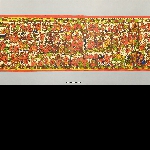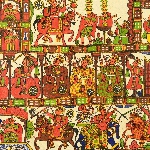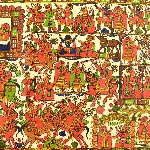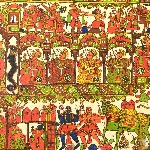Storytelling Back Drop
83-9-1
From: India | Surendranagar | Ahmedabad
Curatorial Section: Asian
| Native Name | Par |
| Object Number | 83-9-1 |
| Current Location | Collections Storage |
| Culture | Indian |
| Provenience | India | Surendranagar | Ahmedabad |
| Period | 20th Century |
| Date Made | 1982 |
| Section | Asian |
| Materials | Cotton |
| Technique | Painted | Woven |
| Iconography | Pabuji |
| Description | A piece of pabuji ki phad, a sacred illustrated scroll that is used as the backdrop of the Pabuji storytelling tradition in Rajasthan and surrounding areas. Pabuji is a historical Rajput hero-god who lived in 13th or 14th century. Phad (par), “rolling and unrolling”, is the painted scroll that accommodates various synoptic scenes from the epic of Pabuji. The cloth is usually rolled from left to right and kept rolled during transit to prevent cracking of the paint. Each phad is a living temple for the deity; it forms the backdrop to the portable shrine. Devotees believe that the warrior god is present in the hanging when they perform puja (worship). Devotional worship is usually carried out by the bhopis (females) and bhopas (males), the “devotee performers” of the folk deities in Rajasthan who travel from village to village to perform the epic. The performance, referred to as the “reading of the par”, usually starts shortly after nightfall. The priests perform various rituals before the reading, including sweeping and burning a stick of incense, to set up for the event. The storytelling usually goes throughout the night and ends early in the morning. This particular example tells the story of "Pabuji and his brothers." It was commissioned by Greg Possehl in Ahmedabad through Mr. Nasir Welderwalla and was painted in the town of Surendranagar in 1982. |
| Length | 449.58 cm |
| Width | 88.9 cm |
| Credit Line | Gift of Gregory L. Possehl, 1983 |
Report problems and issues to digitalmedia@pennmuseum.org.






